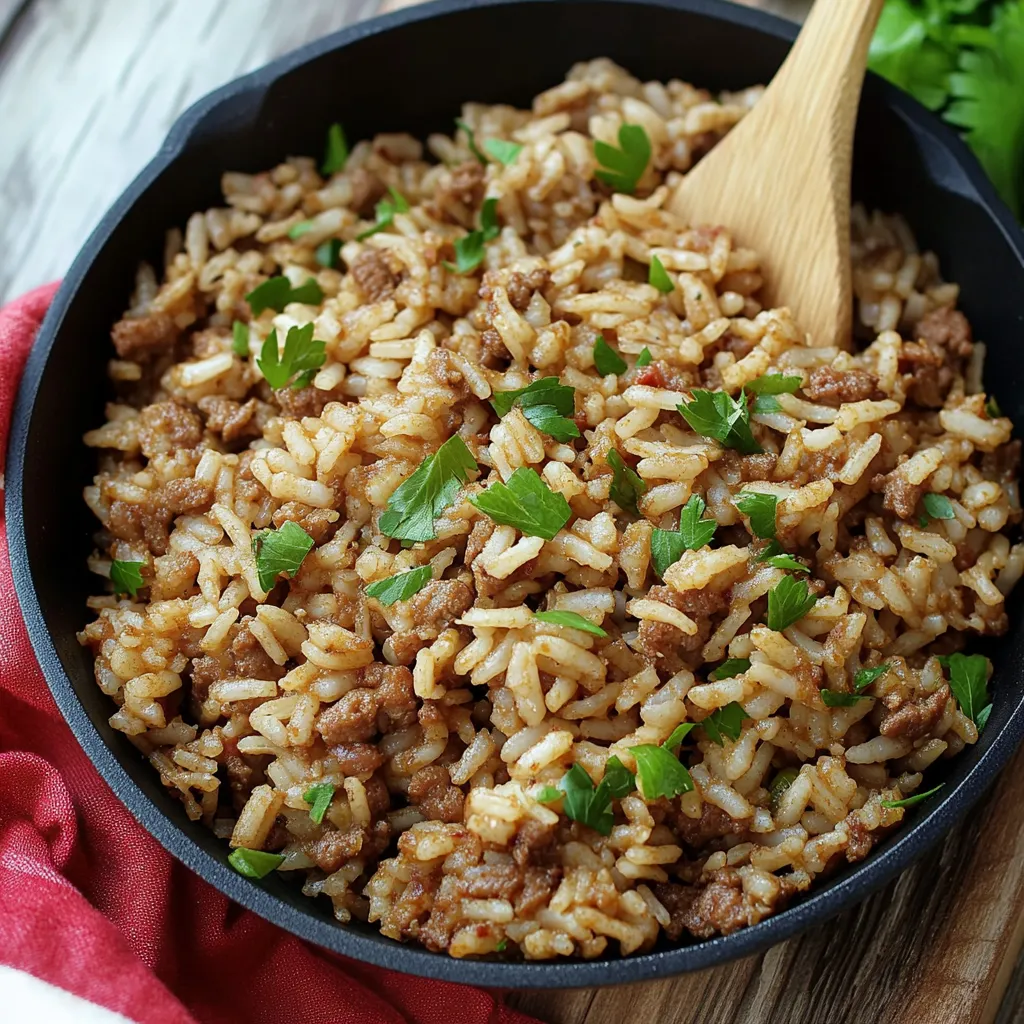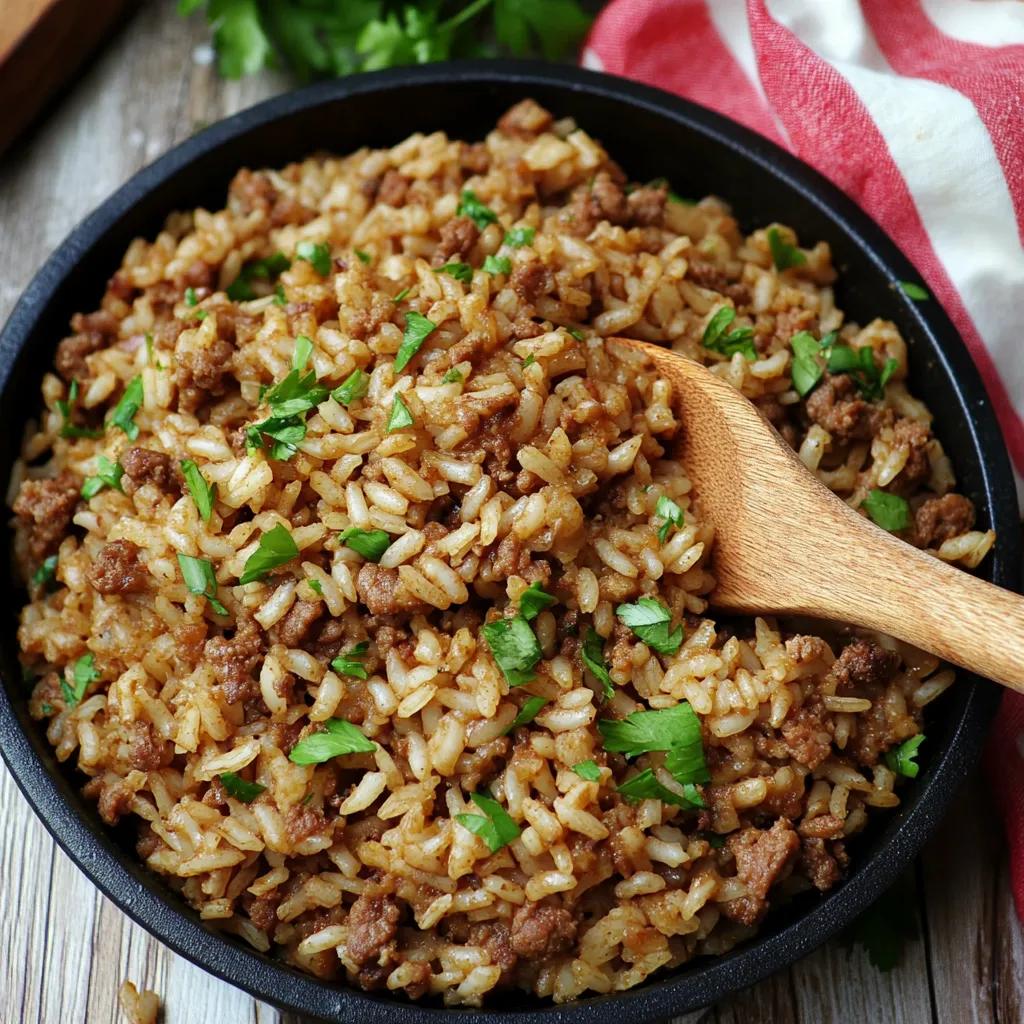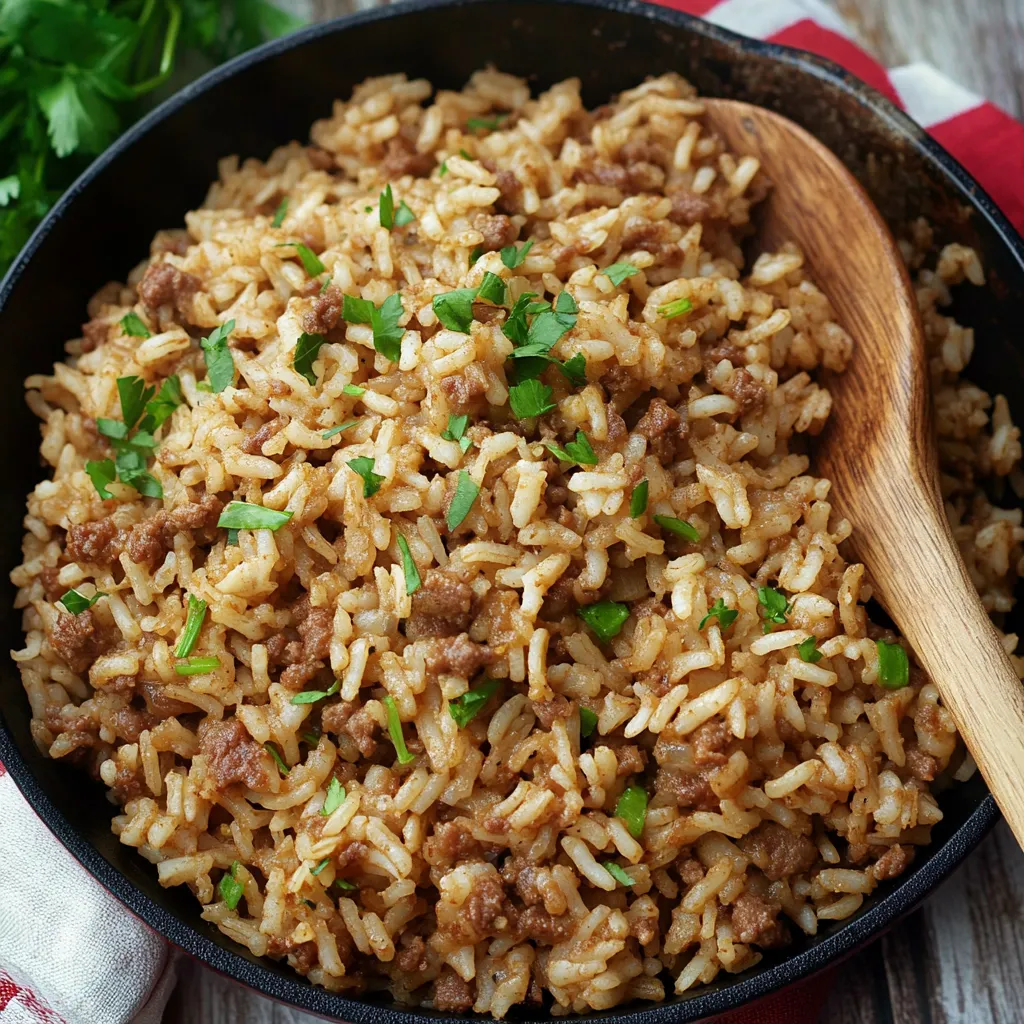 Pin it
Pin it
Dirty Rice
The moment you take your first bite of authentic Louisiana Dirty Rice, you're transported to the heart of Cajun country with its complex layers of savory goodness and aromatic spices. This hearty dish transforms humble ingredients into something truly extraordinary – ground meats render their rich flavors into fluffy rice while the "Holy Trinity" of bell pepper, onion, and celery creates the aromatic foundation that defines Southern Louisiana cooking. What makes Dirty Rice particularly special is how it manages to be both rustic and sophisticated simultaneously. The earthy, deep flavors develop through a careful building process that turns simple components into a cohesive, crave-worthy meal that satisfies on a primal level. Better yet, this one-pot wonder adapts beautifully to any occasion, from casual weeknight dinners to holiday celebrations.
Last month, I brought this Dirty Rice to our neighborhood potluck, and it disappeared faster than any other dish on the table. My neighbor Marcus, who grew up in New Orleans, took one bite and declared it reminded him of his grandmother's kitchen – high praise that validated the authenticity of this recipe. What particularly delighted me was watching guests who had never experienced Dirty Rice before take tentative first bites that quickly turned into enthusiastic second helpings.
Essential Ingredients and Selection Tips
- Ground Meats: The traditional combination of ground beef and spicy pork sausage creates the perfect foundation. The beef provides savory richness while the sausage adds crucial fat and seasoning. Look for sausage with visible spices and at least 20% fat content for the most authentic flavor. For the beef, choose 80/20 ground chuck which offers enough fat to remain juicy without becoming greasy
- The Holy Trinity: Bell pepper, onion, and celery must be diced to similar sizes for even cooking. Select firm, heavy bell peppers (green is traditional, but red adds a subtle sweetness), yellow onions for their balanced flavor when cooked, and inner celery stalks with leaves attached for maximum flavor. This combination forms the aromatic base that distinguishes Louisiana cooking from all others
- Rice: Long-grain white rice creates the ideal texture. Parboiled (converted) rice works particularly well as it maintains distinct grains without becoming mushy. The rice should be cooked separately and slightly underdone since it will continue absorbing liquid when added to the meat mixture
- Seasonings: The spice blend is crucial for authentic flavor. Use fresh garlic rather than pre-minced for pronounced flavor, true Louisiana cayenne for proper heat, and fresh parsley added at the end for brightness. Bay leaves should be fresh or recently purchased as they lose potency quickly
- Chicken Broth: This liquid component carries flavor throughout the dish. Homemade broth provides superior results, but a good-quality, low-sodium store-bought variety works well too. The chicken flavor complements the beef and pork perfectly while adding another dimension to the overall profile
After years of refining this recipe, I've discovered that the order of operations matters tremendously for developing proper flavor. Adding the Holy Trinity to the nearly-browned meat (rather than sautéing it first) allows the vegetables to absorb the rendered fat while releasing their aromatics directly into the meat. This seemingly small detail creates a more cohesive flavor than treating these components separately. Similarly, incorporating flour directly into the meat mixture rather than making a separate roux streamlines the process while still achieving that crucial thickened texture that helps the sauce cling to each grain of rice.
Detailed Cooking Instructions
 Pin it
Pin it
Meat Browning Process
Begin with a heavy-bottomed Dutch oven or deep cast-iron skillet placed over medium-high heat. Add 2 tablespoons of bacon grease or vegetable oil and allow it to heat until shimmering but not smoking. This traditional fat adds an additional layer of smoky depth that commercial oils cannot provide. Add 1 pound of ground beef and 1 pound of ground pork sausage simultaneously, breaking them apart with a wooden spoon as they heat. Allow the meats to cook undisturbed for 2-3 minutes before stirring to develop some crusty brown bits that contribute significant flavor. Continue cooking and breaking the meat into small, uniform pieces – the fine texture is crucial for authentic Dirty Rice. Cook until about 80% browned with some pink still visible before moving to the next step. This partial cooking ensures the meat remains tender through the remaining steps.
Trinity Incorporation
Once the meat has reached the proper stage, add 1 cup finely diced onion, 1/2 cup finely diced green bell pepper, and 1/2 cup finely diced celery directly to the meat mixture. The steam and moisture released from these vegetables will deglaze the bottom of the pan, incorporating all those flavorful browned bits back into the dish. Stir frequently for 4-5 minutes until the vegetables begin to soften and become translucent. The aromatic vegetables should cook in the rendered fat from the meat, absorbing all that flavor while releasing their own essential oils into the mixture. This integration of the Trinity with the meat creates that distinctive Louisiana flavor profile that cannot be achieved any other way.
Seasoning Development
When the vegetables have softened, it's time to layer in the seasonings that give Dirty Rice its soulful character. Add 3 cloves minced garlic and cook for just 30 seconds until fragrant, being careful not to let it brown which would create bitterness. Immediately add 1 teaspoon dried oregano, 1 teaspoon dried thyme, 1 tablespoon chili powder, 1 teaspoon paprika, 1 teaspoon salt, 1/2 teaspoon black pepper, and 1/4 teaspoon cayenne pepper (adjust according to your heat preference). Stir continuously for 1-2 minutes to toast the spices, which intensifies their flavors and helps them permeate the meat more effectively. The fragrance rising from the pot should be complex and intensely aromatic – a good sign that your flavor base is developing properly.
Creating the "Dirty" Element
This crucial step distinguishes true Dirty Rice from simple rice pilaf or jambalaya. Sprinkle 2 tablespoons of all-purpose flour evenly over the meat and vegetable mixture, stirring continuously to ensure it's well distributed with no lumps. The flour will begin to cook in the remaining fat, creating a light roux that will thicken the sauce and give the dish its characteristic texture. Continue stirring for 2 minutes to cook out the raw flour taste. Slowly add 2 cups of chicken broth, stirring constantly to prevent lumps from forming. Add 2 bay leaves and bring the mixture to a simmer. Reduce heat to medium-low and allow it to cook uncovered for 5-8 minutes, stirring occasionally. During this time, the liquid will reduce slightly and thicken, concentrating the flavors. The broth should cling lightly to the meat rather than appearing watery or soupy.
Rice Integration
The final step brings everything together into the cohesive dish that gives Dirty Rice its name. Fold in 4 cups of cooked long-grain white rice, gently turning the mixture to ensure every grain is coated with the flavorful sauce without breaking the rice. Add 2 tablespoons of fresh chopped parsley, reserving a small amount for garnish. Reduce heat to low, cover the pot, and allow it to steam for 5 minutes. This resting period is essential – it allows the rice to absorb the remaining liquid and take on that characteristic "dirty" appearance as it soaks up the rich, brown sauce. After resting, remove the bay leaves, fluff the rice gently with a fork, and serve hot, garnished with the remaining fresh parsley for a bright color contrast against the deep brown rice.
 Pin it
Pin it
Growing up on the border of Louisiana, Dirty Rice was a staple at our family table, though we called it "rice dressing" when served alongside holiday meals. My grandmother insisted that properly made Dirty Rice should stick to your ribs while simultaneously making your taste buds dance – a balance of substance and spice that's characteristic of the best Cajun cooking. She taught me to judge the dish by its color – a proper batch should have a mottled brown appearance that comes from the meat and spices thoroughly integrated into each grain of rice. Too pale meant not enough flavor development; too dark meant the spices had burned. This visual guideline has served me well through decades of making this beloved dish.
Serving Suggestions
This versatile dish bridges the gap between side and main dish beautifully. Serve it as an accompaniment to baked chicken or pork chops, where its robust flavor complements simpler proteins. For a traditional Louisiana meal, pair it with fried okra, collard greens, and cornbread. As a main dish, simply add a crisp green salad with a tangy vinaigrette to cut through the richness. One of my favorite preparations is stuffing bell peppers with Dirty Rice and topping with a sprinkle of cheese before baking – a complete meal that showcases the rice perfectly while adding another layer of flavor from the sweet peppers.
Storage Solutions
One of the many virtues of Dirty Rice is how well it keeps and reheats. Store cooled leftovers in an airtight container in the refrigerator for up to four days. When reheating, add a tablespoon of chicken broth or water per cup of rice to restore moisture, then warm gently in a covered skillet over medium-low heat. For longer storage, Dirty Rice freezes exceptionally well for up to three months. Portion it into freezer-safe containers, leaving slight headspace for expansion. Thaw overnight in the refrigerator before reheating. The flavors actually develop further during storage, making this an ideal make-ahead dish for busy periods.
Creative Variations
While purists might insist on certain elements, Dirty Rice welcomes adaptation to personal preferences. For an extra-authentic version, add 1/4 cup finely chopped chicken livers with the ground meats – they'll practically dissolve during cooking while adding remarkable depth. For a seafood twist, fold in 1 cup of small peeled shrimp or picked crabmeat just before adding the rice. In hunting season, substitute ground venison for the beef for a leaner, more complex flavor. For special occasions, stir in 1/2 cup toasted pecans just before serving for unexpected crunch and nutty richness that complements the savory elements beautifully.
 Pin it
Pin it
Cultural and Historical Context
The beauty of Dirty Rice lies in its humble origins and elevated execution – a perfect representation of Louisiana cooking that transforms simple ingredients through technique and time-honored flavor combinations. Whether you're seeking an authentic taste of the South or simply a satisfying one-pot meal, this recipe delivers on all counts.
Personal Reflection
My journey with this recipe spans generations, connecting me to my Louisiana roots and the cultural heritage that shaped my family's approach to food. What began as a practical way to stretch meat with rice has evolved into a celebrated dish that makes regular appearances at my table.
Final Thoughts
The rich tapestry of flavors, the comforting texture, and the visual appeal of this classic dish continue to earn it a place of honor in kitchens far beyond its Cajun homeland – a testament to how truly great food transcends boundaries while honoring its roots.
Bon appétit! 🍚🌶️
Frequently Asked Questions
- → Can I substitute the meats in this recipe?
- Yes! While the combination of beef and pork sausage is traditional, you can use ground chicken or turkey for a lighter version. For authentic flavor, consider adding 2-3 tablespoons of finely chopped chicken livers.
- → Is there a way to make this gluten-free?
- Absolutely! Simply substitute the flour with 2 tablespoons of cornstarch or rice flour to thicken the mixture.
- → Can I make this dish ahead of time?
- Yes, Dirty Rice actually improves with time as flavors meld. Prepare up to 2 days ahead, refrigerate, and reheat in a skillet with a splash of broth or on low heat in the oven covered with foil.
- → What type of rice works best for this recipe?
- Long-grain white rice is traditional, but medium-grain works too. For best results, cook rice in chicken broth and ensure it's slightly firm (not mushy) before adding to the meat mixture.
- → How spicy is this dish, and can I adjust the heat level?
- As written, this has a mild-to-medium heat. Adjust by changing the amount of cayenne pepper - omit it completely for a mild version or double it for more kick. The type of sausage used also impacts spiciness.
